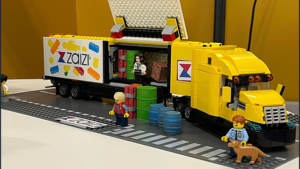
How to use the principles of service design to improve your product or service
Service design is seeing a real boom lately. According to the International Service Design Institute, it’s one of the fastest-growing design disciplines in the world. But why is it becoming so popular?
Focusing on users and customers is really important these days. Research by Deloitte shows that customer-centric companies are 60% more profitable than companies that don’t have this focus — and service design is about applying user-centred design to the real world services people use.
A service helps you do something — like renewing your passport, booking a restaurant reservation online or listening to music on your phone
Economies are also producing more services. This change is driving a shift from a product-centric (focus on individual products) to a service-centric (focus on combining touchpoints or products to deliver customer experiences) way of thinking. Companies are moving away from isolated touchpoints and events, to journeys.
There is a more general change in industries like the public sector. Approaches such as service design are helping solve deep and complex problems and innovating and transforming public services.
Being customer-centric means thinking about everything and everyone involved in fulfilling the customer needs in a service. It’s about designing and crafting each interaction in the end-to-end journey. This end-to-end design process is where service design is valuable to organisations.
We’ve been growing our service design capability at Zaizi and our clients have seen how beneficial and effective this approach has been.
A recap: what’s a service and what is service design?
A service helps you do something — like renewing your passport, booking a restaurant reservation online or listening to music on your phone.
Service design organises and ‘connects’ the systems, tools and people delivering the end-to-end journey in a service. A service can cross online and offline channels.
We use guiding principles to create an end-to-end journey:
- Think about complete systems to design for all external and internal touchpoints. Not just for those consuming the service but also those delivering the service and across every business function and interaction.
- Be co-creative by default and lead the collaborative design process to facilitate the difficult discussions needed to break down silos with teams and stakeholders. This applies in the business setting but outside among users and citizens too.
- Pull the conversations up to the big picture so the focus is placed on the value the service provides, rather than the nuts-and-bolts technology ‘under the hood.’
- Constantly test value and produce designs that benefits users and the organisation, balancing both needs and making these benefits explicit.
Good service design considers the overall customer experience and how it’s delivered.
Take Monzo, for example; it’s transformed how a bank provides services to customers. Customers get real-time data and notifications of every transaction. They can set budget targets, track their spending, pay friends and split bills with ease.
Customers don’t have a physical bank to go to, so there is a higher level of service within its app. This superior customer experience only happens when an organisation takes a user-centred approach across the end-to-end service.
How can you use service design today?
Here are a few tips on how you can use the ideas behind service design to improve the customer experience of your service.
1. Experience the service environment with real users
It sounds simple but a key mistake is not experiencing the environment in which your service is used. It’s often easier to design services based on second-hand information from stakeholders or users. But this means you miss out on important information that could influence how your service is designed or delivered.
Imagine you’re designing a CRM system for a sales organisation. You speak to the sales team to find out what they need and design a UI interface. But if you actually watch the sales team, you may observe other things that you need to consider.
For example, you may notice they actually spend more time outside the office and on their mobiles. So the interface needs to accommodate them being on the move and allow for remote data entry.
If you haven’t already, watch someone in real life interacting with the problem or service you’re delivering. Take notes of things the user does that impacts the effectiveness or usability of your service. These are useful problems that you can take back and find ideas to improve.
2. Map out your service end-to-end and use it to tell a story of your service
Good service design is about understanding your service’s full journey, from start to finish and through all the different channels.
It helps provide a consistent experience for your customers. If you improve one part of the journey but fail in another, your customer will have a poor experience.
Many services include several different departments, staff, systems and interactions. Understanding how these all work together can be difficult but it’s crucial to achieving a superior customer experience. Going through this process can align internal stakeholders, join up siloed teams and help everyone to see things from a different perspective.
If you aren’t sure where to begin, start by drawing an end-to-end map of the current service. Include the different touchpoints the user has with the organisation and the different systems and teams involved in delivering those touchpoints.
If you visualise how you currently deliver for your customers, you can start to unpick problems or see ways to improve things. Perhaps, overlay areas where value is being created, enriched or destroyed.
This work is often called a customer journey map or service blueprint. It helps to combine the interdependent parts of a service and shows how they behave and influence the user’s experience. We’ll go into detail about how you can produce great service blueprints in a later blog.
3. Try to make small incremental improvements
If the first two seem difficult, then a great way to improve your service is to simply focus on making small incremental improvements.
Identify parts of the service that may not provide value for the business or the user and see how you can make it better or remove it completely. It could be making the internal workflow leaner so you can respond quickly to inquiries, or removing unnecessary data capture so users don’t have to fill in as much information.
Any small part you can streamline in your service will make things simpler for users and result in a better experience.
How are we applying service design at Zaizi?
Our service designers are working on many exciting projects across government. A lot of the work is very complex, has many moving parts and involves cross-departmental work.
At the moment, most of our service design work takes place during discovery. At this early stage, the perspectives, overall approach and the ‘framing’ of the problem-space starts. Our work helps clients define the:
- overall scope and trajectories
- value
- strategic target end-state
- parts of a service that can change (and which ones cannot)
We have also been working with SFIA to update its definition of service design. We’ve had discussions with government figures to find common ground between the different definitions across Government Digital Service, UK Home Office DDaT, SFIA Foundation and others.
SFIA really needs our input and views to make the definition as representative, accurate, and ‘right’ as possible. If you’re interested, see how you can get involved.
We’re also using service design internally to help bring a more user-centred approach across the business. We’re working on a design community to consolidate and share best practices.
Over the coming months, we’ll delve deeper into service design so check our blog section regularly and follow us on LinkedIn and Twitter for updates.
Get in touch if you would like to know more about Service Design and how it can help your organisation.
Related content
-

The great legacy escape: Ditch the spreadsheets, drop the paper
Published on: 4 June, 2025 -

The great legacy escape: How outdated systems and processes still hold government back
Published on: 29 May, 2025 -

GDS’s research into AI in government – and how to deliver real value
Published on: 1 May, 2025 -

From ScanApp to Lego demos — What you need to know about Security & Policing 2025
Published on: 1 April, 2025
